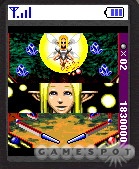Dragon Edge Pinball asserts its East Asian provenance even more readily than you would expect of a game with "Dragon" in the title. From its ridiculous, fast-paced background music track to its host of colorful, cartoonish foes, Dragon Edge feels more like a console role-playing game boss battle than a pinball game. Featuring graphical effects and animations that would be impressive by any standard, Dragon Edge is a game you might expect to appear on a Series 60 handset. Not so. We tested Dragon Edge on the aging Sanyo 8100, on which it played at a smooth frame rate despite all the large sprites that were displayed. Yet while such a game would be highly recommendable based on all those factors, Dragon Edge's questionable ball physics unfortunately keep it short of greatness.
Dragon Edge Pinball shares its genre's standard objective of achieving a high score. The way you earn points, however, is fairly unusual: you have to defeat a series of enemies that are firmly rooted in the fantasy mode. You'll have to contend with an anthropomorphic tree, a viridian-tinted phoenix, a smelly troll, and even an animated skull. These baddies have formed a coalition of evil, apparently imprisoning a fairy princess by firmly and defiantly planting themselves in the center of your pinball table.

Your adversaries are only vulnerable on their soft underbellies, so you'll have to aim your shots accordingly. Unfortunately, this is really difficult, as Dragon Ball's wonky physics make it hard to predict where your ball's going to end up. In a typical pinball setting, hitting the ball about five-eighths of the way down your paddle should send it flying directly toward your enemy. In Dragon Edge Pinball, however, this is true only a fraction of the time. Hitting each creature a sufficient number of times is harder than it would be ordinarily.
Dragon Edge's table has two tiers, with the upper one pretty much resembling a typical table. You've got your average complement of bumpers and loop-de-loops. The only peculiarity of the upper tier is the dragon gargoyle that sits in the upper right-hand corner. If you manage to aim a shot into his mouth, your ball will be charged up, making it a more formidable weapon to be used against troll, bird, or tree. Again, though, it's very difficult to aim your ball, so it's more likely that you'll end up in the dragon's fearsome maw by simple chance.
If you manage to free the fairy, she'll appear in a beam of white light and bestow upon you the ultimate gift...an extra ball and the chance to free her again. While this might sound anticlimactic, consider for a second that you're criticizing the plot of a pinball game.
Dragon Edge Pinball looks great and sounds even better. It's got heaps of charm and it's a fairly entertaining. Pinball is largely a game of angles and measures, though, and the quality of any computer pinball simulation is therefore contingent on its physics engine. This is not exactly Dragon Edge's strong suit. Somehow, the game is still a pretty fun play, just not nearly to the degree that it could have been.